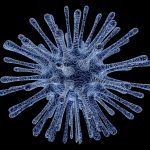
Osmotic dehydration is the removal of water by immersing a food in a solution of sugars or salt which exert a very high osmotic pressure. The osmotic pressure drives water from the food into the solution.
Historically, osmotic dehydration has been practiced ever since it was discovered that salt or sugar could not only reduce microbial loading but also modify food. Candying fruits or angelica to produce those wonderful sweets and confections is a classic example of this process. Add to this, the salting of fish. In both cases not only is water removed but there is movement of the solute in the other direction to permeate the flesh of the produce. Hence, we have salted cod (bacalao) or candied fruit peel which has a rich sweetness from the infused sugar. Industrially, the production of semi-candied fruit remains the largest commercially viable process using this technology.
The literature on the whole process is huge but the process is simple. Some very good review articles exist tracing the early studies on the process (Torreggiani, 1993). In some articles it is known as the dewatering and impregnation soaking process (DIS process) (Raoult-Wack, 1994).
Foodstuffs Treated By Osmotic Dehydration
- acerola cherry (Malpighia punicifolia) (Alves et al., 2005)
- aonla (amla) (Alam et al., 2010)
- apple
- banana (Mercali et al., 2010).
- Opuntia ficus-indica (Cactus) (Alves et al., 2008).
The produce is prepared as slices, peels, cut food to create a surface area for ready dehydration. The pieces are immersed in highly concentrated solutions of salt or sugar. In the case of sugar, these may be glucose, sucrose, trehalose, gluconic acid etc. During the process water moves out of the flesh of the produce into the water solution where it ultimately begins to dilute it. Correspondingly, there is a movement of the ‘osmotic solute’ into the flesh. Depending on how long the food is left in the osmotic solution dictates the level of permeation.
The process conditions and the composition and concentration of the osmotic solute dictate the total or maximum level of dehydration. Generally, the process system is designed to minimise the transport losses of other components which can occur. The process is largely batch operated although continuous operations are feasible at small-scale or pilot scale levels.
To keep the osmotic pressure high, the solution is recycled and replaced every so often. Very often this osmotic solution is thermally concentrated for the purpose of re-use. Energy consumption in removing water is extremely low especially when compared to a conventional drying process. The levels of energy consumption are still economical even when multi-stage evaporation or reverse osmosis are employed in the regeneration process.
The rate of water removal is fastest at the beginning when the osmotic differential in pressure is at its maximum. As the osmotic pressure difference drops through dilution by the water coming out of the food, the rate slackens off. To be economical in terms of the rate of drying, the process must be stopped and the osmotic solution regenerated to its full osmotic potential.
In many cases, the osmotically dried food is still too moisture active i.e. contains too much moisture to be shelf stable. The process is sometimes regarded as an intermediate step in the drying process and as a way of creating a new type of food with the infused solutes. These foods are then sent on for further processing such as freezing, drying or or thermal processing.
One important feature of the process is that the structural integrity of the produce generally remains unchanged and that full rehydration is often possible. However there are a number of situations where this is not observed. Osmotic dehydration of melon causes a loss of shape of the cell wall, cells breaking apart from each other and breakdown of the tissue (Fernandes et al., 2008).
The transport mechanisms in water movement are more complicated than imagined. Clearly there is some Fickian diffusion and effective diffusivity coefficients have been calculated for a range of foods which helps in determining rates of drying and times taken for processing. However the process is complicated by the presence of intercellular barriers such as cell membranes which interfere with mass transfer. There are also differences in the various phases that water moves through as with the cell contents.
Knowledge of the microstructure of the food pieces including areas available for water transport need to be examined. In the dehydration of melon, when the process is less than 30 minutes, water diffusivity drops as sugar moves in the other direction but increases after an hour because the cells breakdown lowering their resistance to water diffusion (Fernandez et al., 2008). To improve the situation ultrasound is applied as a pretreatment which increases water diffusivity by forming microscopic channels in the melon’s flesh and so reduces the resistance to water diffusion. Ultrasound incidentally did not cause tissue breakdown.
Techniques to raise the rate of mass transfer include application of high hydrostatic pressures, high electrical field pulses, vacuum and centrifugal forces (Rastogi et al., 2002). Ultrasound has already been mentioned.
Vacuum osmotic dehydration has advantages over the process conducted at atmospheric pressure. A vacuum helps speed up the rate of water mass transfer. Better water loss and food weight reduction are possible under these conditions (Fito, 1994).
References
Alam, M.S., Amarjit, S. & Sawhney, B.K. (2010). Response surface optimization of osmotic dehydration process for aonla slices. Journal Food Science Technology, 47, pp. 47–54 (Article)
Alves, D.G., Barbosa, J.L. Jr, Antonio, G.C.A. & Murr, F.E.X. (2005). Osmotic dehydration of acerola fruit (Malpighia punicifolia L.). Journal of Food Engineering, 68, pp. 99–103
Alves, M.A., de Souza, A.C.M., Gamarra-Rojas, G. & Guerra, N.B. (2008). Fruto de palma (Opuntia ficus-indica (L) Miller, Cactacecae): morfologia, composic¸a˜o quı´mica, fisiologia, ı´ndices de colheita e fisiologia po´s- colheita. Revista Ibereroamericana Tecnologı´a Postcosecha, 9, pp. 16–25. .
Fernandes, F. A., Gallão, M. I., & Rodrigues, S. (2008). Effect of osmotic dehydration and ultrasound pre-treatment on cell structure: melon dehydration. LWT-Food Science and Technology, 41(4), pp. 604-610. (Article)
Fito, P. (1994) Modelling of Vacuum osmotic Dehydration of Food. in: Water in Foods. Fundamental Aspects and Their Significance in Relation to Processing of Foods. pp. 313-328 (Article)
Mercali, G.D., Tessaro, I.C., Norena˜ , C.P.Z. & Marczak, L.D.F. (2010). Mass Transfer kinetics during osmotic dehydration of bananas (Musa sapientum, shum). International Journal of Food Science and Technology, 45, pp. 2281–2289.
Raoult-Wack, A. L. (1994). Recent advances in the osmotic dehydration of foods. Trends in Food Science & Technology, 5(8), pp. 255-260 (Article)
Rastogi, N. K., Raghavarao, K. S. M. S., Niranjan, K., & Knorr, D. (2002). Recent developments in osmotic dehydration: methods to enhance mass transfer. Trends in Food Science & Technology, 13(2), pp. 48-59 (Article).
Torreggiani, D. (1993) Osmotic dehydration in fruit and vegetable processing. Food Res. Int. 26(1) pp. 59-68 (Article)



Leave a Reply